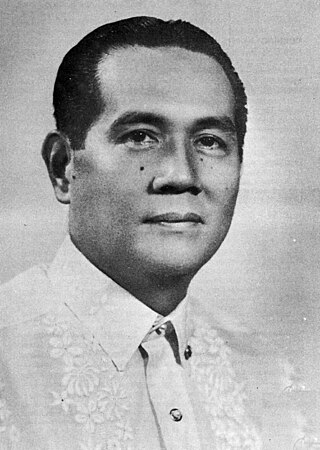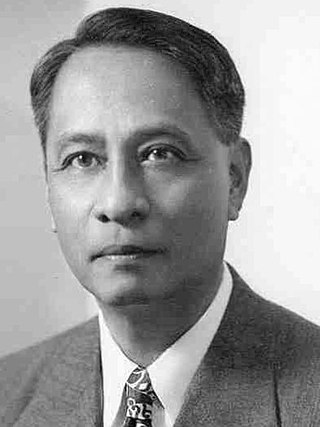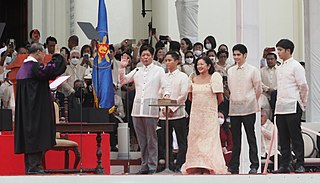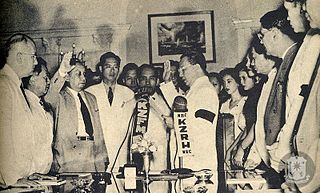
The Commonwealth of the Philippines was an unincorporated territory and commonwealth of the United States that existed from 1935 to 1946. It was established following the Tydings–McDuffie Act to replace the Insular Government of the Philippine Islands and was designed as a transitional administration in preparation for full Philippine independence. Its foreign affairs remained managed by the United States.

The president of the Philippines is the head of state, head of government and chief executive of the Philippines. The president leads the executive branch of the Philippine government and is the commander-in-chief of the Armed Forces of the Philippines.

Elpidio Rivera Quirino was a Filipino lawyer and politician who served as the 6th president of the Philippines from 1948 to 1953.
The governor-general of the Philippines was the title of the government executive during the colonial period of the Philippines, governed by Mexico City and Madrid (1565–1898) and the United States (1898–1946), and briefly by Great Britain (1762–1764) and Japan (1942–1945). They were also the representative of the executive of the ruling power.

Sergio Osmeña Sr. was a Filipino lawyer and politician who served as the fourth president of the Philippines from 1944 to 1946. He was vice president under Manuel L. Quezon. Upon Quezon's sudden death in 1944, Osmeña succeeded him at age 65, becoming the oldest person to assume the Philippine presidency until Rodrigo Duterte took office in 2016 at age 71. A founder of the Nacionalista Party, Osmeña was also the first Visayan to become president.

Diosdado Pangan Macapagal Sr. was a Filipino lawyer, poet and politician who served as the ninth president of the Philippines, serving from 1961 to 1965, and the sixth vice president, serving from 1957 to 1961. He also served as a member of the House of Representatives, and headed the Constitutional Convention of 1970. He was the father of Gloria Macapagal Arroyo, who followed his path as president of the Philippines from 2001 to 2010.

Manuel Acuña Roxas was a Filipino lawyer and politician who served as the fifth president of the Philippines from 1946 until his death in 1948. He served briefly as the third and last president of the Commonwealth of the Philippines from May 28, 1946, to July 4, 1946, and became the first president of the independent Third Philippine Republic after the United States ceded its sovereignty over the Philippines.

The Philippine Red Cross is a non-profit humanitarian organization and a member of the International Red Cross and Red Crescent Movement.

This article covers the history of the Philippines from the recognition of independence in 1946 to the end of the presidency of Diosdado Macapagal that covered much of the Third Republic of the Philippines, which ended on January 17, 1973, with the ratification of the 1973 Constitution of the Republic of the Philippines.
This list of presidential elections in the Philippines includes election results of both presidential and vice presidential elections since 1899 with the candidates' political party and their corresponding percentage.

The First Congress of the Commonwealth of the Philippines, also known as the Postwar Congress, and the Liberation Congress, refers to the meeting of the bicameral legislature composed of the Senate and House of Representatives, from 1945 to 1946. The meeting only convened after the reestablishment of the Commonwealth of the Philippines in 1945 when President Sergio Osmeña called it to hold five special sessions. Osmeña had replaced Manuel L. Quezon as president after the former died in exile in the United States in 1944.

The Treaty of Manila of 1946, formally the Treaty of General Relations and Protocol, is a treaty of general relations signed on July 4, 1946 in Manila, the capital of the Philippines. It relinquished U.S. sovereignty over the Philippines and recognized the independence of the Republic of the Philippines. The treaty was signed by High Commissioner Paul V. McNutt as representative of the United States and President Manuel Roxas as representative of the Philippines.

The inauguration of the president of the Republic of the Philippines is a ceremony marking the commencement of the six-year term of a president of the Philippines, who is both head of state and head of government. The inauguration is performed on June 30, as mandated by the 1987 Constitution. Under the older 1935 Constitution, the date was December 30, which is also Rizal Day; the last inauguration held on the older date was Ferdinand Marcos' second one on December 30, 1969. The most recent public presidential inauguration ceremony was that of President Bongbong Marcos, who began his six-year term in office on Thursday, June 30, 2022.

The 1946 Philippine presidential and vice presidential elections were held on April 23, 1946, pursuant to Commonwealth Act No. 725. Incumbent president Sergio Osmeña ran for a full term, but was defeated by senator Manuel Roxas. Meanwhile, senator Elpidio Quirino defeated fellow senator Eulogio Rodriguez to become vice president.
Elecions for the president, vice-president, members of the Senate, members of the House of Representatives and local positions were held on April 23, 1946, pursuant to Commonwealth Act No. 725

The first inauguration of Elpidio Quirino as the sixth president of the Philippines took place on April 17, 1948 at the Council of State Room of the Malacañan Palace in Manila, under extraordinary circumstances. The inauguration marked the commencement of the first term of Elpidio Quirino as President, following the death of President Manuel Roxas two days earlier. The associate justice of the Supreme Court administered the oath of office. On the same day, Quirino delivered his short, 47-word inaugural remarks at the same room.

The first inauguration of Manuel Roxas as the fifth president of the Philippines and the last president of the Philippine Commonwealth under the United States took place on May 28, 1946, at the ruins of Legislative Building in Manila, which was ruined during the World War II. The inauguration marked the beginning of Manuel Roxas's only term as president and of Elpidio Quirino's only term as vice president. The chief justice of the Supreme Court administered the oath of office.
1946 in the Philippines details events of note that happened in the Philippines in 1946.













